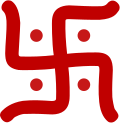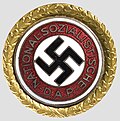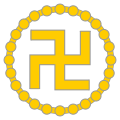Swastika
The Swastika is a cross with its arms bent at right angles, in either left-facing or right-facing forms.[1] It is a widely-used religious symbol in Hinduism, Buddhism and Jainism.[2] The symbol was also used in pre-Christian Europe. The word "Swastika" became part of the English language in the nineteenth century with the British conquest of India. In the 1920s, the Nazi party chose the swastika as its symbol and it is for this association that it is best known in the Western world.[3]
Religious use
The Swastika is a sacred symbol in Hinduism, Buddhism and Jainism.[4] It is also a sign of spiritual purity. The swastika was a letter in the ancient Sanskrit language. It meant luck or well being.[4] It is also found on Byzantine buildings, Ancient Greek coinage and in Native American burial sites.[4]
In Nazi Germany
The swastika was a symbol used by the Nazi Party in Germany, and later by the Third Reich. Adolf Hitler chose it as the symbol of the German Workers Party after he joined. Before Hitler, members had already worn swastika armbands. (They believed they were adopting an ancient European symbol; they were seemingly unaware of its continued use in the East.) Hitler was responsible for its red, white and black coloring.[5] From 1935 – 1945 it was used on the German flag.[5] The symbol became stigmatized because of its association with Nazi war crimes.[5]
Since shortly after World War II, it has been illegal in Germany and Austria to display the swastika and other Nazi symbols. The swastikas on Hindu, Buddhist, and Jain temples are exempt from this law, because religious symbols cannot be banned in Germany.[6]
Naming dispute
Since at least the early 2000s, Hindus, Buddhists and Jains have become more and more upset and annoyed to see their holy symbol being used as a badge of hatred by racists and neo-Nazis.[7] One way that they have tried to reestablish their symbol as one of peace and good fortune is to try to encourage use its name in German, Hakenkreuz (hooked cross), when writing about the Nazis' version of it. (Although the Asian religions usually show the symbol in vertical/horizontal orientation and the Nazis usually showed it diagonally, neither group, especially the Nazis, did so consistently.) As of 2022, it does not seem that this campaign has achieved success. The Western media continue to use the name "swastika" when writing about neo-Nazi use of the symbol.[8]
Gallery
Heinrich Pudor's völkisch Treu Deutsch ('True German') 1918 with a swastika. From the collections of Leipzig City Museum.
Golden Party Badge of the Nazi Party with a black swastika rotated 45 degrees on a white disc.
Adapted "Sun Cross", official symbol of the völkisch German Faith Movement (1934–1945)
Swastika Media
The appropriation of the swastika by the Nazi Party is the most recognisable modern use of the symbol in the Western world.
Drawing of a swastika on the Snoldelev Stone found in Ramsø, Denmark (9th century)
Depiction of comets from the Book of Silk, Han dynasty, 2nd century BCE
Pima symbol of the four winds
Rock painting in the caves of Gegham mountains, Armenia
- لاخ مزار.jpg
The Lakh Mazar, a pre-historic carving in Iran
Armenian arevakhach
References
| Wikimedia Commons has media related to Lua error in Module:Commons_link at line 62: attempt to index field 'wikibase' (a nil value).. |
- ↑ "Gowing, Nicholas Keith, (Nik), (born 13 Jan. 1951), Main Presenter, BBC World News, BBC News, 2000–14 (Presenter, 1996–2000); Visiting Professor, King's College London, since 2014", Who's Who, Oxford University Press, 2007-12-01, doi:10.1093/ww/9780199540884.013.u17734, retrieved 2022-04-08
- ↑ Snodgrass, Adrian (1992). The symbolism of the stupa (1st Indian ed.). Delhi: Motilal Banarsidass. ISBN 81-208-0781-2. OCLC 28492832.
- ↑ Cambridge advanced learner's dictionary (3rd ed.). Cambridge: Cambridge University Press. 2008. ISBN 978-0-521-71266-8. OCLC 600728996.
- ↑ 4.0 4.1 4.2 Suresh Chandra, Encyclopaedia of Hindu Gods and Goddesses (New Delhi: Sarup & Sons, 1998), p. 333
- ↑ 5.0 5.1 5.2 Martha Cheung Pui Yiu; Lin Wusun, An Anthology of Chinese Discourse on Translation (Oxford; New York: Routledge, 2014), p. 202, n. 328
- ↑ "Germany Won't Seek EU-Wide Ban on Swastikas". Deutsche Welle. 29 January 2007.
- ↑ Heller, Steven (2008). The Swastika: Symbol Beyond Redemption?. New York: Allworth Press. ISBN 978-1-58115-507-5.
- ↑ Teitel, Emma (11 February 2022). "Truck protest teaches timely lessons about the current face of antisemitism". www.thestar.com. Toronto Star. Retrieved 15 February 2022.
Other websites
- The History of the Swastika Archived 2018-12-25 at the Wayback Machine














